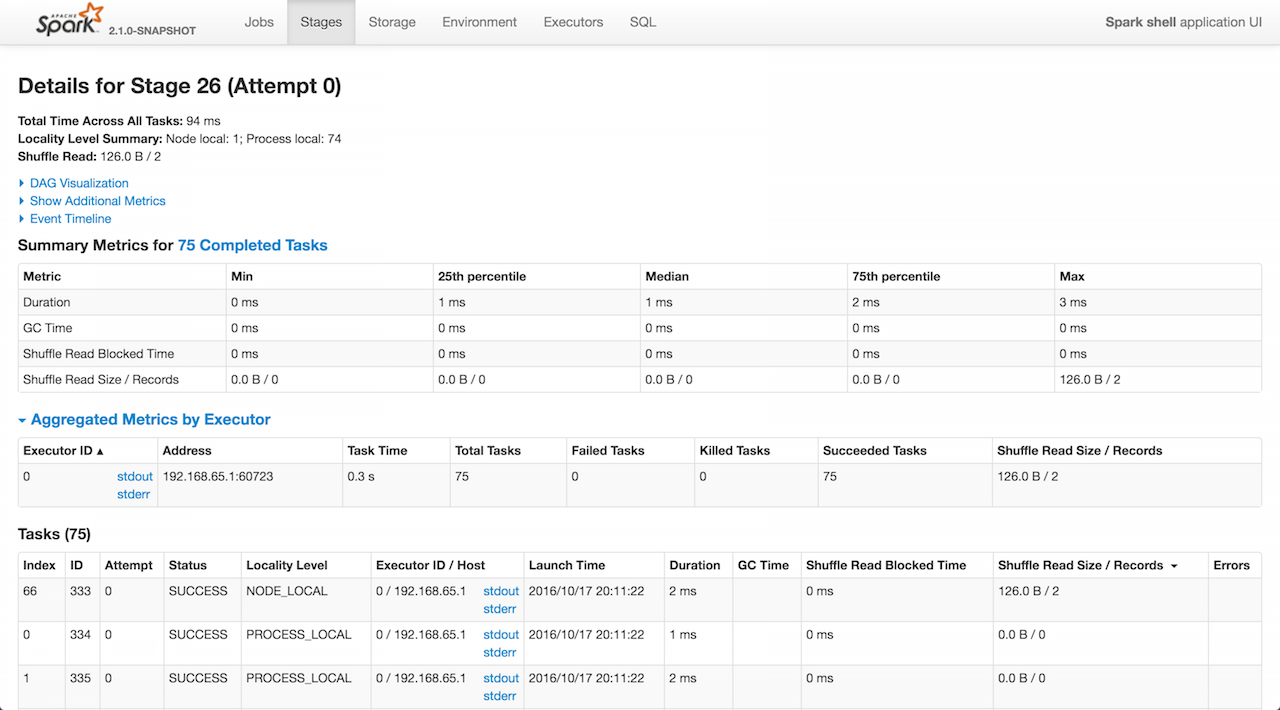
Stage Details
StagePage shows the task details for a stage given its id and attempt id.

StagePage renders a page available under /stage URL that requires two request parameters — id and attempt, e.g. http://localhost:4040/stages/stage/?id=2&attempt=0.
StagePage is a part of Stages tab.
StagePage uses the parent’s JobProgressListener and RDDOperationGraphListener to calculate the metrics. More specifically, StagePage uses JobProgressListener's stageIdToData registry to access the stage for given stage id and attempt.
StagePage uses ExecutorsListener to display stdout and stderr logs of the executors in Tasks section.
Tasks Section
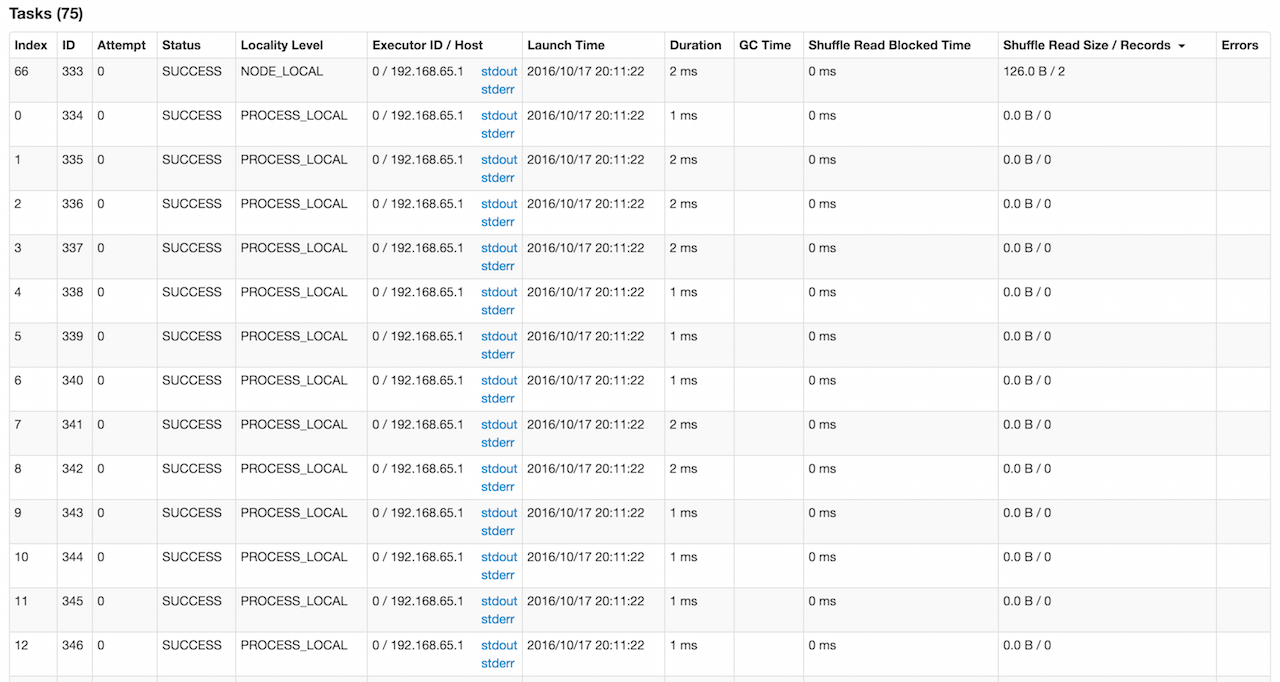
Tasks paged table displays StageUIData that JobProgressListener collected for a stage and stage attempt.
|
Note
|
The section uses ExecutorsListener to access stdout and stderr logs for Executor ID / Host column.
|
Summary Metrics for Completed Tasks in Stage
The summary metrics table shows the metrics for the tasks in a given stage that have already finished with SUCCESS status and metrics available.
The table consists of the following columns: Metric, Min, 25th percentile, Median, 75th percentile, Max.
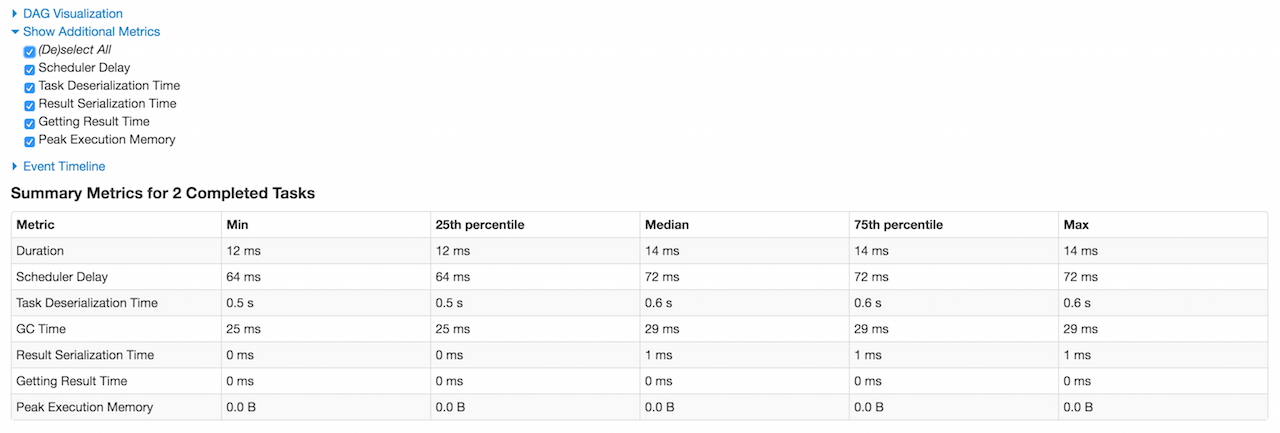
|
Note
|
All the quantiles are doubles using TaskUIData.metrics (sorted in ascending order).
|
The 1st row is Duration which includes the quantiles based on executorRunTime.
The 2nd row is the optional Scheduler Delay which includes the time to ship the task from the scheduler to executors, and the time to send the task result from the executors to the scheduler. It is not enabled by default and you should select Scheduler Delay checkbox under Show Additional Metrics to include it in the summary table.
|
Tip
|
If Scheduler Delay is large, consider decreasing the size of tasks or decreasing the size of task results. |
The 3rd row is the optional Task Deserialization Time which includes the quantiles based on executorDeserializeTime task metric. It is not enabled by default and you should select Task Deserialization Time checkbox under Show Additional Metrics to include it in the summary table.
The 4th row is GC Time which is the time that an executor spent paused for Java garbage collection while the task was running (using jvmGCTime task metric).
The 5th row is the optional Result Serialization Time which is the time spent serializing the task result on a executor before sending it back to the driver (using resultSerializationTime task metric). It is not enabled by default and you should select Result Serialization Time checkbox under Show Additional Metrics to include it in the summary table.
The 6th row is the optional Getting Result Time which is the time that the driver spends fetching task results from workers. It is not enabled by default and you should select Getting Result Time checkbox under Show Additional Metrics to include it in the summary table.
|
Tip
|
If Getting Result Time is large, consider decreasing the amount of data returned from each task. |
If Tungsten is enabled (it is by default), the 7th row is the optional Peak Execution Memory which is the sum of the peak sizes of the internal data structures created during shuffles, aggregations and joins (using peakExecutionMemory task metric). For SQL jobs, this only tracks all unsafe operators, broadcast joins, and external sort. It is not enabled by default and you should select Peak Execution Memory checkbox under Show Additional Metrics to include it in the summary table.
If the stage has an input, the 8th row is Input Size / Records which is the bytes and records read from Hadoop or from a Spark storage (using inputMetrics.bytesRead and inputMetrics.recordsRead task metrics).
If the stage has an output, the 9th row is Output Size / Records which is the bytes and records written to Hadoop or to a Spark storage (using outputMetrics.bytesWritten and outputMetrics.recordsWritten task metrics).
If the stage has shuffle read there will be three more rows in the table. The first row is Shuffle Read Blocked Time which is the time that tasks spent blocked waiting for shuffle data to be read from remote machines (using shuffleReadMetrics.fetchWaitTime task metric). The other row is Shuffle Read Size / Records which is the total shuffle bytes and records read (including both data read locally and data read from remote executors using shuffleReadMetrics.totalBytesRead and shuffleReadMetrics.recordsRead task metrics). And the last row is Shuffle Remote Reads which is the total shuffle bytes read from remote executors (which is a subset of the shuffle read bytes; the remaining shuffle data is read locally). It uses shuffleReadMetrics.remoteBytesRead task metric.
If the stage has shuffle write, the following row is Shuffle Write Size / Records (using shuffleWriteMetrics.bytesWritten and shuffleWriteMetrics.recordsWritten task metrics).
If the stage has bytes spilled, the following two rows are Shuffle spill (memory) (using memoryBytesSpilled task metric) and Shuffle spill (disk) (using diskBytesSpilled task metric).
Request Parameters
id is…
attempt is…
|
Note
|
id and attempt uniquely identify the stage in JobProgressListener.stageIdToData to retrieve StageUIData.
|
task.page (default: 1) is…
task.sort (default: Index)
task.desc (default: false)
task.pageSize (default: 100)
task.prevPageSize (default: task.pageSize)
Metrics
Scheduler Delay is…FIXME
Task Deserialization Time is…FIXME
Result Serialization Time is…FIXME
Getting Result Time is…FIXME
Peak Execution Memory is…FIXME
Shuffle Read Time is…FIXME
Executor Computing Time is…FIXME
Shuffle Write Time is…FIXME
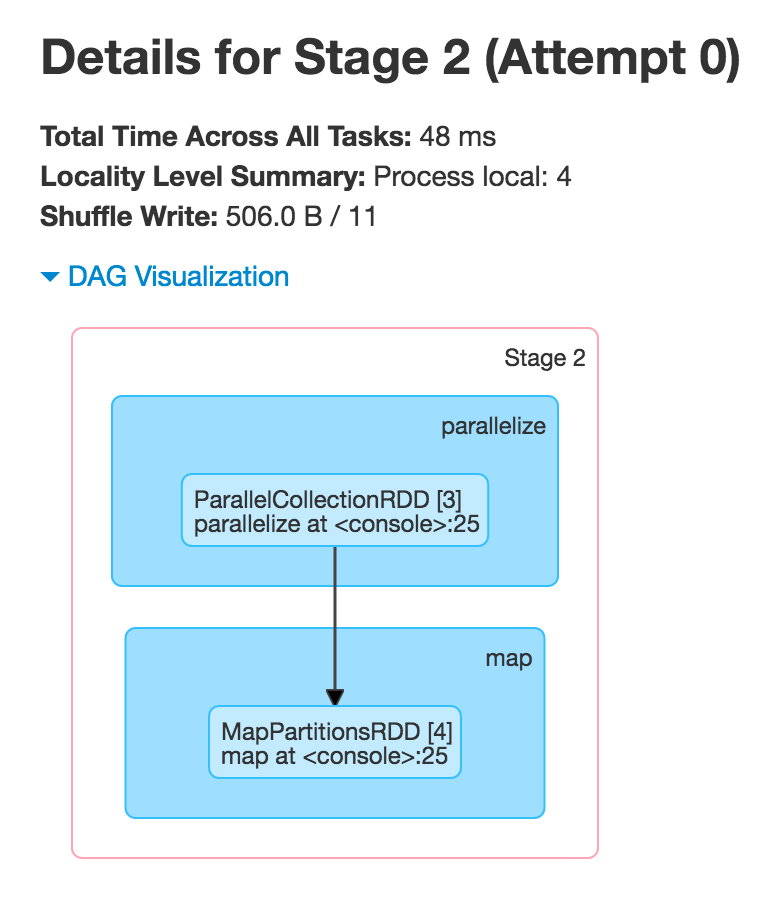
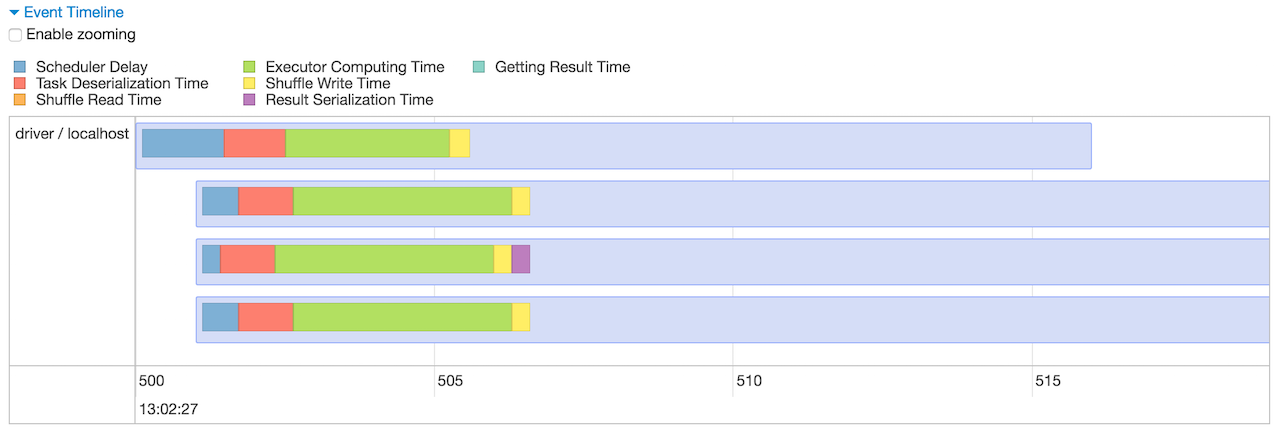
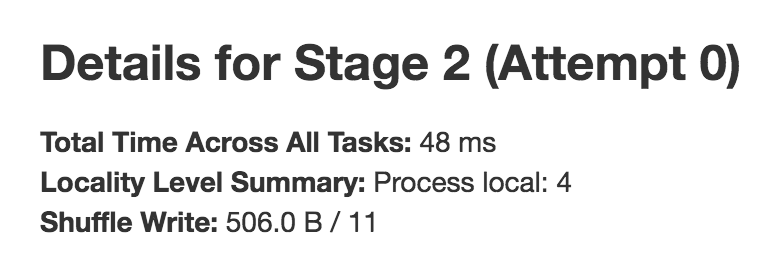
Aggregated Metrics by Executor
ExecutorTable table shows the following columns:
-
Executor ID
-
Address
-
Task Time
-
Total Tasks
-
Failed Tasks
-
Killed Tasks
-
Succeeded Tasks
-
(optional) Input Size / Records (only when the stage has an input)
-
(optional) Output Size / Records (only when the stage has an output)
-
(optional) Shuffle Read Size / Records (only when the stage read bytes for a shuffle)
-
(optional) Shuffle Write Size / Records (only when the stage wrote bytes for a shuffle)
-
(optional) Shuffle Spill (Memory) (only when the stage spilled memory bytes)
-
(optional) Shuffle Spill (Disk) (only when the stage spilled bytes to disk)

It gets executorSummary from StageUIData (for the stage and stage attempt id) and creates rows per executor.
It also requests BlockManagers (from JobProgressListener) to map executor ids to a pair of host and port to display in Address column.
Accumulators
Stage page displays the table with named accumulators (only if they exist). It contains the name and value of the accumulators.

|
Note
|
The information with name and value is stored in AccumulableInfo (that is available in StageUIData). |